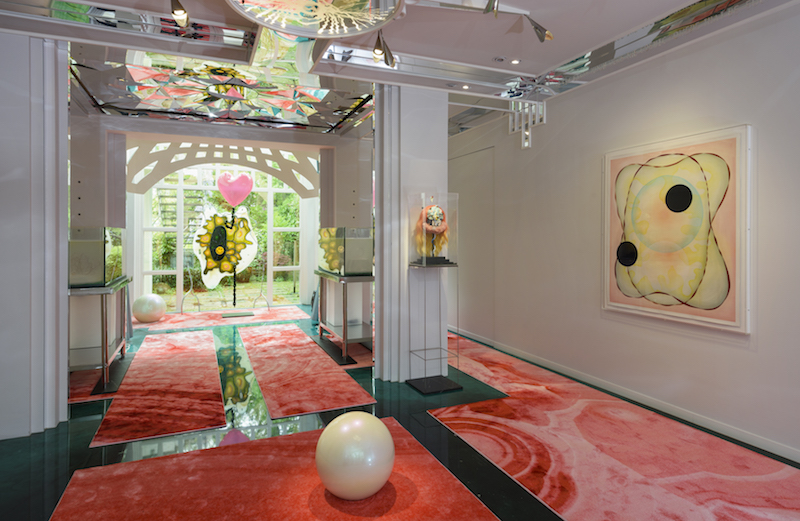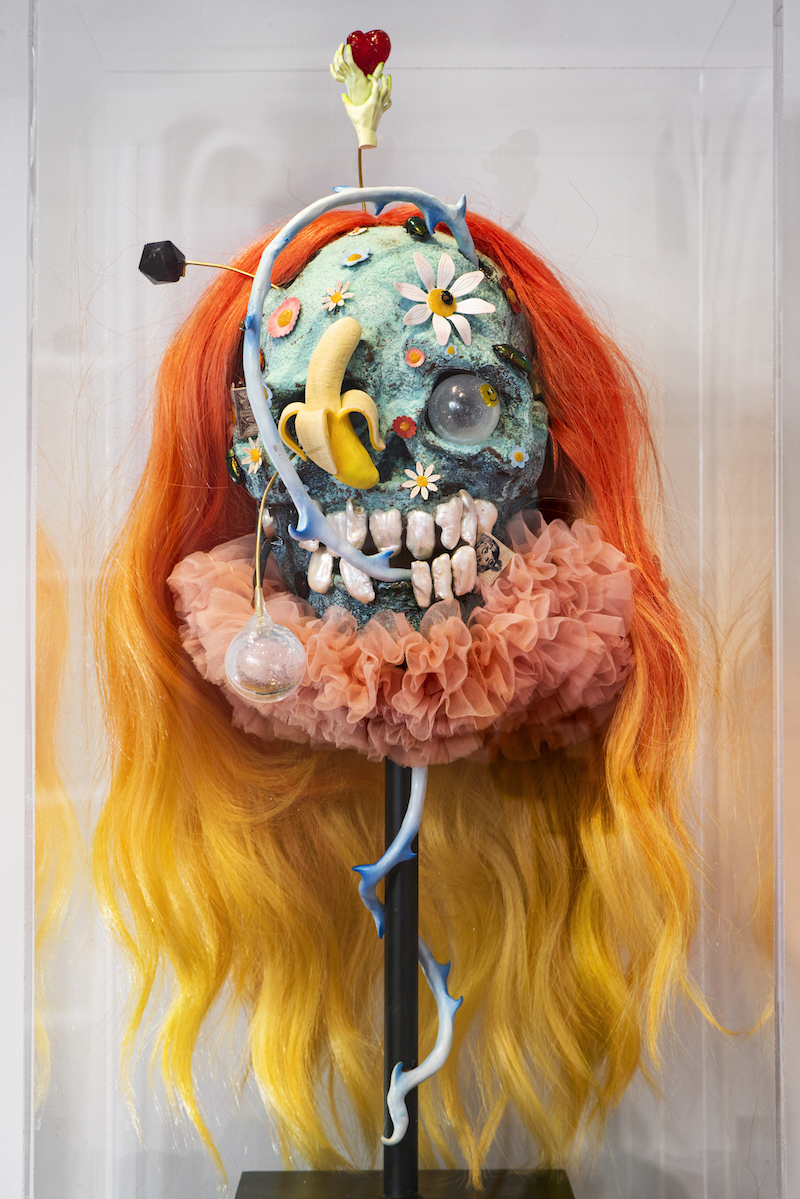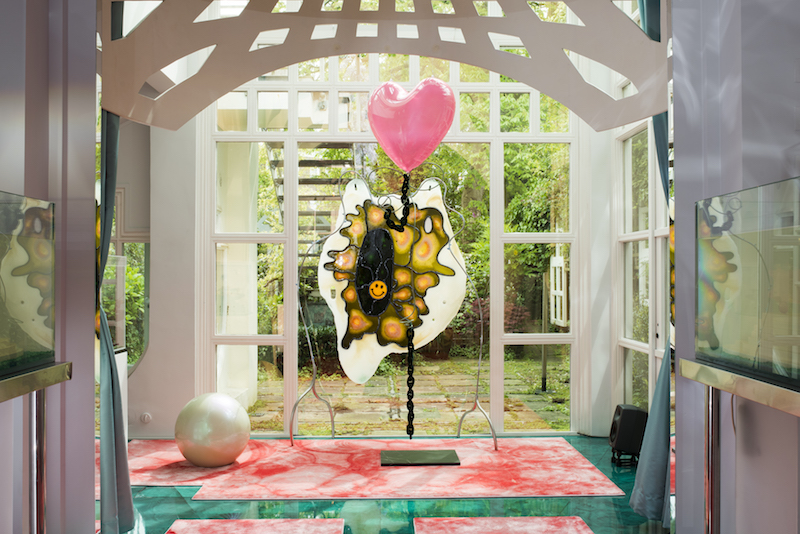by William Kherbek // Nov. 12, 2024
This article is part of our feature topic Alien.
In thinking about what makes something—or someone—alien, the question of perspective is central. The differentiation between “native” and “alien” ultimately concerns the side of the line on which one falls. And all lines (straight ones at least) are imaginary. What to make then, of the cosmic mindset of the architect and writer Charles Jencks, as manifested in the space that was once his home near Holland Park London, and which is now known as The Cosmic House? Jencks’ home is a space that both admits all aliens and denies the alien. Indeed, if the cosmic view is about nothing else, it’s about drawing the line of division at the exact scale of the universe itself and working backwards. For those who don’t know his background, Jencks is perhaps best known outside of the architecture world for introducing the concept of postmodernism into popular discussion. It is undeniable that postmodernism has been tried and found guilty of a number of sins over recent decades, associated as the term sometimes is with circular philosophical rhetoric, or a studied wackiness in presentation aimed at levelling high and low cultures, the legacies of which are not entirely salutary. Nevertheless, with that said, Jencks was a man who lived by his principles, even when they led in directions that could only be justly described as “wacky.” Currently, his meticulously preserved residence is hosting a site-specific—and sites don’t get much more specific than The Cosmic House—installation by the Turner Prize-winning artist Tai Shani.

Tai Shani: ‘The World to Me Was a Secret: Caesious, Zinnober, Celadon, and Virescent,’ 2024, installation view // Photo by Thierry Bal, courtesy of the Jencks Foundation at The Cosmic House
Fitting the work of Shani into The Cosmic House is a delicate matter, in that Shani’s works often deal with the vexed boundaries between interiors and exteriors, and the installation ‘The World to Me Was A Secret: Caesious, Zinnober, Celadon, and Virescent’ undoubtedly treads uneven terrains between the familiar and the alien. As the title suggests, it is a show that expects a fair bit from the visitor (if you’re finding Shani’s chromatic lexicon a bit recondite, the words loosely translate as blue-grey, jade, vermillion and greenish). Perhaps this is an underrated approach in the present moment of instant aesthetic gratification. The world Shani presents is singular but not unwelcoming. Alien without being alienating.
There’s a lot of everything in Shani’s exhibition, which is perfectly in keeping with what might be thought of as the Jencks meta-vibe. A heart floats in the air despite being bound by a chain to the earth. A perfectly formed sphere, black and white, sits on a swirly decorated red carpet afloat a virescent floor, not far from the inverted Borromini dome that served Jencks in life as a jacuzzi. Diagrams of celestial bodies look down from mirrored surfaces above. A wobbly stained glass work misbalances the light from the November London sun as it passes through a door to the Jencks’ back garden and into the space. Then there’s a turquoise—not really caesious to my eyes—skull, festooned with all manner of accoutrements, teeth, springy hearts, a half-exposed banana. It is perhaps a difficult moment to think of the aesthetics of the skull, in a time of merciless global war and, less bleakly, a moment not so distant from Halloween. But thinking about it, that juxtaposition came to seem fruitful to me: we attempt to estrange ourselves from our fears of the most intimate signifier of all, the skull beneath the skin, once goblin season rolls around.

Tai Shani: ‘The World to Me Was a Secret: Caesious, Zinnober, Celadon, and Virescent,’ 2024, installation view // Photo by Thierry Bal, courtesy of the Jencks Foundation at The Cosmic House
There is also a literary lineage to be explored in Shani’s show. In the accompanying text, as in the space, Shani is concerned with that which lies beyond the familiar. “Uncanny” seems a somewhat inadequate way of conveying the works on show, however, as they are explicitly concerned with the unassimilable, the monstrous (specifically Frankenstein’s monster in the text). Shani is said to have had Frankenstein in mind during her brief residency in the space, at which time she wrote the text. The writing offers an oneiric meander across intensely uneven geographies, with Jencks’ notion of the Promethean informing the dynamics of repulsion and desire it explores. For those who know, the subtitle of Mary Shelley’s proto-science fiction classic, ‘Frankenstein,’ is ‘The Modern Prometheus.’ In Shani’s text, there is an overwhelming undercurrent that the vagaries of our desires are beyond our knowledge, which is an interesting contrast to the encompassing sureties that seem to inform Jencks’ cosmic vision. The question of what is “knowable” seemed a significant subplot in the Shani exhibition and its dialogue with the House. Particularly the ways in which an external presence, the alien artist, enters such a carefully preserved and maintained space. Even an artist as sympathetic to aspects of Jencks’ worldview as Shani is, would feel confronted with the overwhelming presence of the absent Mr. Jencks. For me the riotousness and the irresolvablilty of some of Shani’s works, particularly the insectile life teeming at the margins of the fishtanks she presents, lent a welcome dimension to the carefully plotted rational irrationality of Jencks’ vision.

Tai Shani: ‘The World to Me Was a Secret: Caesious, Zinnober, Celadon, and Virescent,’ 2024, installation view // Photo by Thierry Bal, courtesy of the Jencks Foundation at The Cosmic House
Beyond the Shani installation, alien visitors are also to be found in another part of The Cosmic House, that of Sonia Leimer’s exhibition a few floors above, entitled ‘Cosmic Dust.’ The work explicitly considers the ways in which the terrestrial and extraterrestrial interact through the medium of dust. Dust on the microscope or telescope lens is the clearest evidence of all of the connection between the cosmic and the sublunary; dust to dust isn’t simply a biblical dictum, it is a description of how matter forms and disperses in the world. In the light of Leimer’s and Shani’s interventions in The Cosmic House, the generative frictions (and fictions) produced brought home a critical revelation about the domestic space, coded as it is with the ideologies that are often so familiar they disappear: from our deepest core we are always aliens, even—or perhaps especially—when we are at home.
Exhibition Info
The Cosmic House
Tai Shani: ‘The World to Me Was A Secret: Caesious, Zinnober, Celadon, and Virescent’
Exhibition: May 1–Dec. 20, 2024
jencksfoundation.org
19 Lansdowne Walk, London W11 3AH, UK, click here for map



















